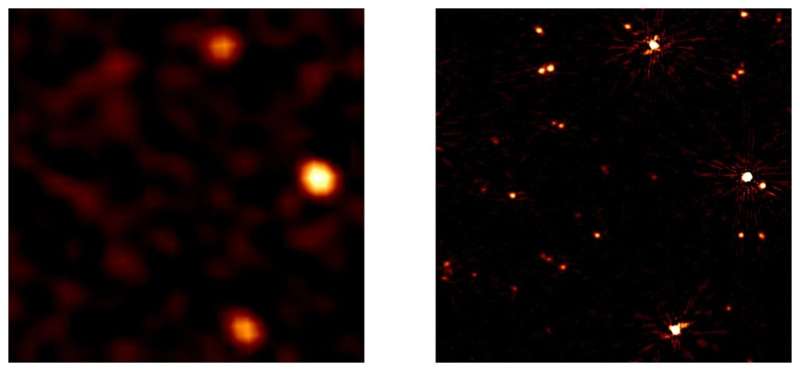This article has been reviewed according to Science X's editorial process and policies. Editors have highlighted the following attributes while ensuring the content's credibility:
fact-checked
peer-reviewed publication
trusted source
proofread
Astronomers have a new way to bypass Earth's atmosphere

Radio telescopes have an advantage over optical telescopes, in that radio telescopes can be used even in cloudy conditions here on Earth. That's because the longer wavelengths of radio waves can pass through clouds unhindered.
However, some wavelengths are still partially obscured by portions of Earth's atmosphere, especially by the ionosphere which traps human-made Radio Frequency Interference (RFI).
Astronomers have developed a new calibration technique that allows them to take sharp images in low radio frequencies—between 16 and 30 MHz—for the first time, bypassing the influence of the ionosphere. The astronomers say this will allow them to study things like plasmas emanating from ancient black holes and perhaps even detect exoplanets that orbit small stars.
The technique was developed by an international team of researchers led by astronomers from Leiden University in the Netherlands.
"It's like putting on a pair of glasses for the first time and no longer seeing blurred," said Christian Groeneveld from Leiden University, who led the research, which is now published in Nature Astronomy.
The astronomers used the LOFAR telescope in Drenthe, the Netherlands, which is currently one of the best low-frequency radio telescopes in the world. They modified a calibration technique that has been used to improve observations for observing in radio at higher frequencies, around 150 MHz.
"We hoped that we could also extend this technique to lower frequencies, below 30 MHz," said Reinout van Weeren, also from Leiden University, who came up with the idea. "And we succeeded."
To test their technique, they studied several galaxy clusters that had previously only been studied in detail at higher frequencies.
"Our observing strategy consisted of simultaneously observing a bright primary calibrator and the target fields," the team wrote in their paper. "By scheduling the observation after midnight, we minimized RFI caused by the internal reflection of terrestrial RFI by the ionosphere, which is significantly worse during the day, as ionizing radiation from the sun increases the column density of ions in the ionosphere."
Then, they split up their field of view into several smaller "facets" and self-calibrated each facet individually, against the calibrator object. "This yields an improved image and model of the sky, partly corrected for direction dependent effects," they wrote. They then repeated the calibrations three more times.
This was the first time radio images at frequencies between 16 and 30 MHz have been taken. Because of this data, the astronomers said that the radio emissions from these clusters are not evenly distributed across the entire cluster, but rather there is a spot pattern.
According to the researchers, the new calibration technique makes it possible to study radio phenomena at frequencies that were previously hidden.
"There is, of course, a chance that we will eventually discover something unexpected," said Groeneveld.
More information: C. Groeneveld et al, Characterization of the decametre sky at subarcminute resolution, Nature Astronomy (2024). DOI: 10.1038/s41550-024-02266-z. On arXiv: arxiv.org/abs/2405.05311
Journal information: Nature Astronomy , arXiv
Provided by Universe Today




















